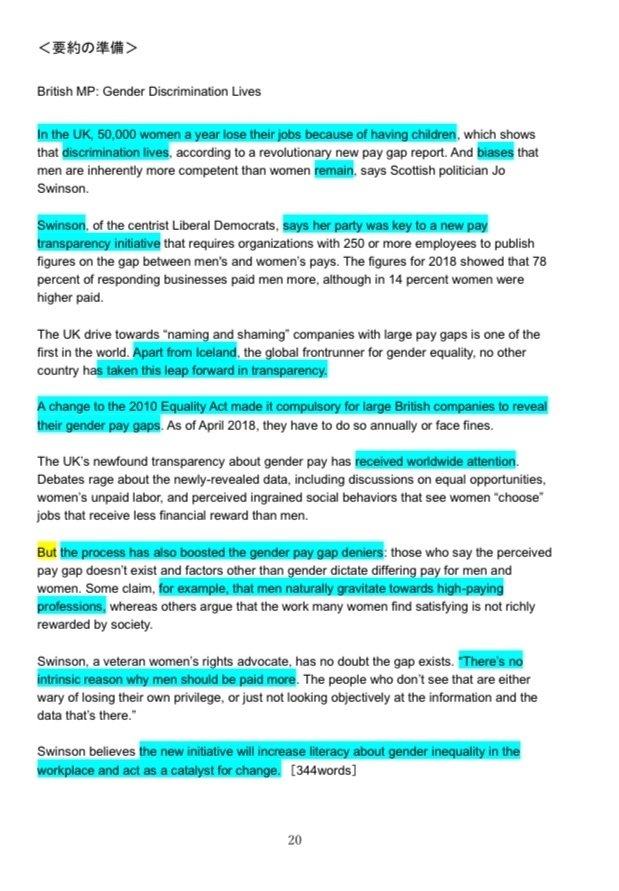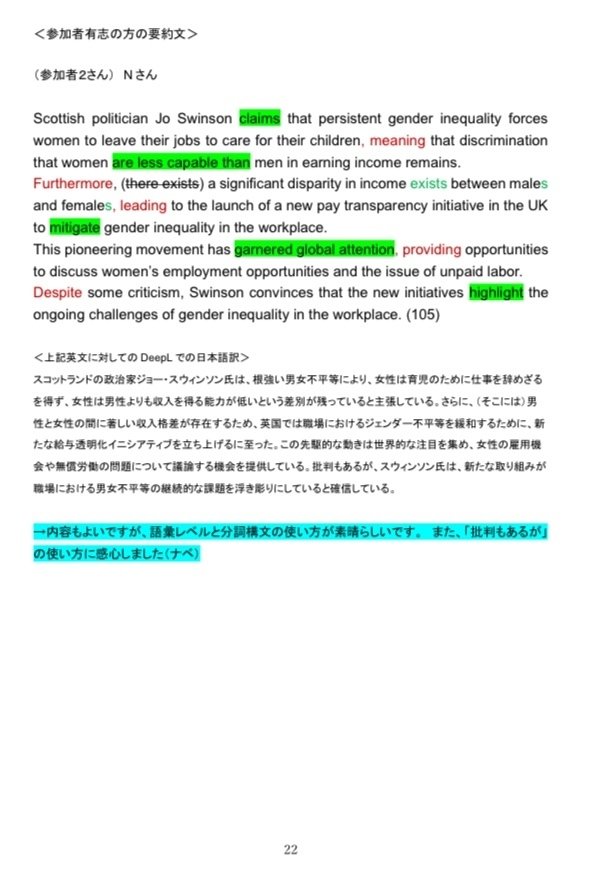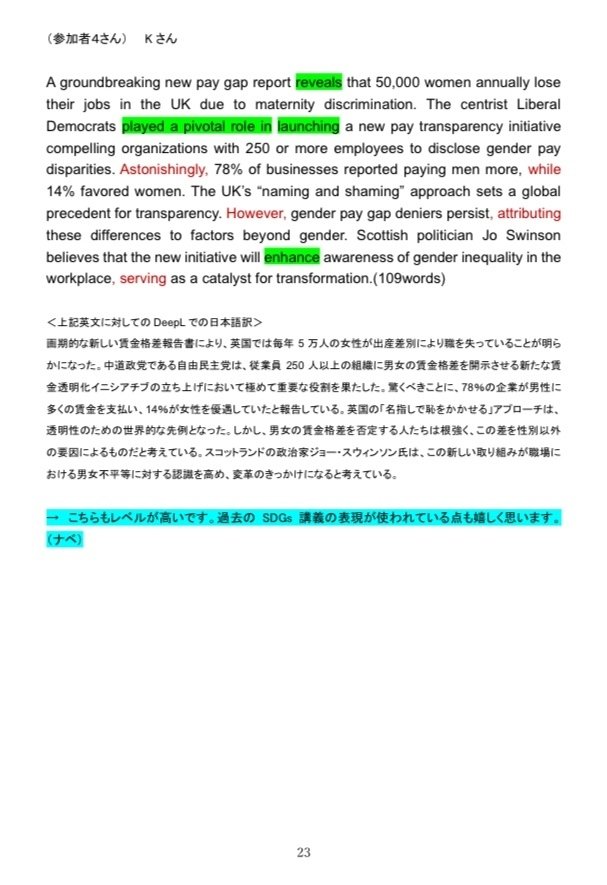
<英検1級の要約問題>6つの課題文とナベ+3名の受講生さんの要約文(添削結果):SDGs講義のDAY1-DAY6>
1.はじめに
2024年第1回の英検1級一次試験に、要約文という新たな試験が導入されるので、どのように対策すべきかと考えていたら、「ナベが、実際に書いてみればよい。受講生さんと一緒に考えればよいのでは?」という考えに至り、SDGs講座の中で、要約文の課題も入れてみようと思い、2月末からはじめました。
また、第2回からは、毎回、受講生さんのうち、有志の方に、要約文を提出してもらい、それをZOOM講義中に解説する(もちろん、ナベの要約文も、受講生さんにみてもらう・・・審判をあおぐ)ということを繰り返して、現時点[2024年4月20日(土)]でDAY8まで講義が終わっています。
特に、同じ英検1級を目指す受講生さん同士の要約文を共有しあうことでら、受講生さんもナベも、多くを学んでいるので、今回、それらをnote記事にしようと思いました。ナベの要約文と受講生さんの要約文は有料となってしまいますが、課題文は、無料公開しますので、もし、この記事を読んでくれた方で、要約問題に挑戦したい方は、挑戦してもらえればと思います。
2.SDGs講義とは

元々は、上記スライドで告知して、長文読解+要約文(+英作文)の講義を目指したのですが、予想外に、要約文と英作文の部分が好評で、DAY4以降は、以下のような時間配分で開催しています
21:00~21:20 SDGs記事の長文読解(設問つき)
21:20~21:45 要約文の解説と、受講生さん有志の要約文の紹介(平均10名分)
21:45:~22:00 SDGsテーマに関連する英作文の解説(ナベの英作文+有志の方の英作文:約3名分)
なお、要約文は、講義終了後に、次回の課題文を共有していて、希望者には、「追加料金なし」で要約文を提出してもらっています。
→ 英作文は、ZOOM講義代の800円に加えて、+500円を請求
3.6つの課題文
このnote記事には、以下の6つの課題文を掲載しています
(以下の6つはニュース記事で、DAY7以降は、英検HPのサンプル問題を参考に作成した独自問題でSDGs講義を進めています。講義がもっと進捗したら、別途、DAY7以降のnote記事を作成します)
課題文: One-Time Investments Reduce Poverty for 10 Years
課題文: World Food Program Wins Nobel Peace Prize
課題文: Blue Spaces: Why Water Makes Us Healthy And Happy
課題文: Education in Conflict Zones: An Unmet Need
課題文: British MP: Gender Discrimination Lives
課題文: A Sick Planet: Study Shows Earth's Declining Health
4.SDGs講義~DAY1(Goal-1)関連の課題文: One-Time Investments Reduce Poverty for 10 Years
課題文: One-Time Investments Reduce Poverty for 10 Years
Researchers from the Massachusetts Institute of Technology have found that giving people living in poverty a one-time economic "boost" is enough to improve their lives even 10 years later.
The study was based on a program targeting people living in extreme poverty in West Bengal, India. The program started in 2007, offering 266 households the choice of receiving either farm animals — cows or goats — or inventory for other types of small businesses. Eighty-two percent chose the animals.
The households were also given an allowance of about $7.60 a week for 30-40 weeks, and 18 months of weekly visits for health, life and business advice.
The researchers examined the effects of this economic boost with surveys 18 months after the program began, then after three years, seven years and 10 years.
The economic well-being of the households was measured by how much they spent on goods and services, their household incomes, food security and health. The results were then compared with similar households that chose not to take part in the program.
After 10 years, participating households went from spending an average of $1.35 a day per person to an average of $3.53 a day per person. Households that didn't take part in the program only went from spending $1.35 to spending $2.90 per person.
Participants' household incomes also rose from $170 a month after 18 months to $680 a month after 10 years. Non-participating households saw an increase too, but only from $144 at 18 months to $497 at year 10.
The study noted that at first the participating households earned more just by having more farm animals. However, those same households were then better able to find new and different sources of income over time.
The participating households also experienced less food insecurity and had better health.
"The social benefits seem to be overwhelmingly larger than the costs," said study co-author Abhijit Banerjee. The researchers determined that the program cost about $2,200 per household — but resulted in about $8,200 in benefits for each household after 10 years. [338words]
5.SDGs講義~DAY2(Goal-2)関連の課題文: World Food Program Wins Nobel Peace Prize
課題文: World Food Program Wins Nobel Peace Prize
The World Food Program (WFP) has won the Nobel Peace Prize for fighting hunger and seeking to end its use as "a weapon of war and conflict."
Announcing the prize, the Norwegian Nobel Committee said it wished "to turn the eyes of the world towards the millions of people who suffer from or face the threat of hunger."
The committee also said it hoped that giving the prize to the UN agency would highlight the need to strengthen global cooperation.
The Rome-based agency was established in 1961 at the behest of US President Dwight Eisenhower. It has brought aid to multiple crises, including Ethiopia's famine of 1984, the Asian tsunami of 2004, and the Haiti earthquake of 2010.
It continues to bring assistance to the world's most dangerous places, from air-dropping food in South Sudan and Syria to creating an emergency delivery service that continued providing aid even as the coronavirus pandemic grounded commercial flights.
The organization is led by David Beasley, a Republican former South Carolina governor nominated for the job by President Donald Trump. The agency has been run by an American for nearly 40 years.
Beasley said the prize rightly goes to his entire team.
"I know I'm not deserving of an award like this — but all the men and women around the world in the World Food Program and our partners who put their lives on the line every day to help those in need, that is inspiring and encouraging," he told The Associated Press.
However, some have noted that WFP's top donors are also major food exporters and often involved in the sale of arms to conflict zones where the agency works, from Afghanistan to Yemen.
The Nobel Peace Prize comes with a gold medal and a $1.1 million cash prize. So far in 2020, WFP has received almost $6.4 billion in cash or goods, with over $2.7 billion coming from the US. [318words]
6.SDGs講義~DAY3(Goal-3)関連の課題文: Blue Spaces: Why Water Makes Us Healthy And Happy
課題文: Blue Spaces: Why Water Makes Us Healthy And Happy
Picnics on a beach, boating on a lake, or a riverside stroll — people are naturally attracted to water. Research now shows that activities like these are important for our health and well-being.
The physical and mental health benefits of spending time in green spaces — such as parks, gardens, or woods — are already well-known.
However, for around a decade, evidence has been growing that blue spaces — such as rivers, lakes and the sea — are also good for our health in a variety of ways.
Whether people enjoy water sports or a simple walk on the beach, studies have shown that those who live near to blue spaces are more likely to be physically active.
Regular visits to blue spaces have also been shown to improve mental health. One study found that although people are generally happier in natural environments, they are happiest in blue spaces.
And as people tend to enjoy activities together in blue spaces, they are also good for our social health.
Another important point is that blue spaces can create healthier environments, cooling the temperature in cities and cleaning the air.
With all these benefits, could doctors prescribe time in blue spaces for their patients?
This is actually happening in the UK, where doctors can now refer patients with mental health problems to a "blue prescribing" program. Over several weeks participants spend time in blue spaces taking part in activities such as bird-watching, canoeing, walking, and having picnics.
The results have been very positive, with participants saying that being in the blue space helps them to relax and feel less stressed.
Surf therapy is also growing in popularity around the world as a way to treat mental health problems and has been shown to reduce depression and anxiety.
However, you don't need to go surfing to enjoy blue spaces. Just looking at the sea or listening to the sound of water is known to be relaxing. And research has shown that spending around two hours a week in a blue space is enough to bring health benefits. [338words]
7.SDGs講義~DAY4(Goal-4)関連の課題文:Education in Conflict Zones: An Unmet Need
課題文:Education in Conflict Zones: An Unmet Need
The California-based charity Justice Rising is working to educate young people in conflict zones, especially the conflict-torn eastern section of the Democratic Republic of Congo. It is one of many organizations struggling to meet a need that is largely unmet in troubled areas worldwide, according to the United Nations International Children’s Fund, UNICEF.
UNICEF says 27 million children are unable to attend school in conflict zones such as Syria, South Sudan, Iraq and Yemen, as well as areas divided by religion and resources, such as Nigeria and Niger.
According to a 2016 report from the UNESCO Institute for Statistics, 236 million children, adolescents, and youth are out-of-school. This represents nearly one-fifth of the global population within this age group.
The gap in children’s education leaves a void in their social development, said Linda Jones, senior education specialist with UNICEF, noting it has an impact on society as well. She said that getting children into schools contributes to a nation’s stability.
Schools can be a catalyst for change, said Cassandra Lee, founder of Justice Rising. “If we cluster the schools,” she said, “have multiple schools in a community, we can see them come out of war and into a culture of peace.”
Less than 4 percent of global humanitarian appeals fund education, said Linda Jones. UNICEF says it will spend one billion dollars a year over the next four years on education.
Jones says the programs need to be flexible. “We have that with examples in Afghanistan,” she said, “with community schools where the schools reach out to the village where the children are,” in effect taking classrooms to the children. “There are also programs with learning through radios,” she added, and using games on tablet computers to hone math skills.
Jones has worked in Somalia, where some solutions were low-tech. “Children had libraries brought to them on the backs of camels,” she said, and, “The librarian walked with the camel from place to place... Children had opportunities to learn to read different books.”
Without education, say UNICEF officials, poverty and instability can become entrenched, harming successive generations. [348words]
8.SDGs講義~DAY5(Goal-5)関連の課題文:British MP: Gender Discrimination Lives
課題文:British MP: Gender Discrimination Lives
In the UK, 50,000 women a year lose their jobs because of having children, which shows that discrimination lives, according to a revolutionary new pay gap report. And biases that men are inherently more competent than women remain, says Scottish politician Jo Swinson.
Swinson, of the centrist Liberal Democrats, says her party was key to a new pay transparency initiative that requires organizations with 250 or more employees to publish figures on the gap between men's and women’s pays. The figures for 2018 showed that 78 percent of responding businesses paid men more, although in 14 percent women were higher paid.
The UK drive towards “naming and shaming” companies with large pay gaps is one of the first in the world. Apart from Iceland, the global frontrunner for gender equality, no other country has taken this leap forward in transparency.
A change to the 2010 Equality Act made it compulsory for large British companies to reveal their gender pay gaps. As of April 2018, they have to do so annually or face fines.
The UK’s newfound transparency about gender pay has received worldwide attention. Debates rage about the newly-revealed data, including discussions on equal opportunities, women’s unpaid labor, and perceived ingrained social behaviors that see women “choose” jobs that receive less financial reward than men.
But the process has also boosted the gender pay gap deniers: those who say the perceived pay gap doesn’t exist and factors other than gender dictate differing pay for men and women. Some claim, for example, that men naturally gravitate towards high-paying professions, whereas others argue that the work many women find satisfying is not richly rewarded by society.
Swinson, a veteran women’s rights advocate, has no doubt the gap exists. “There’s no intrinsic reason why men should be paid more. The people who don’t see that are either wary of losing their own privilege, or just not looking objectively at the information and the data that’s there.”
Swinson believes the new initiative will increase literacy about gender inequality in the workplace and act as a catalyst for change. [344words]
9.SDGs講義~DAY6(Goal-6)関連の課題文:A Sick Planet: Study Shows Earth's Declining Health
課題文: A Sick Planet: Study Shows Earth's Declining Health
Earth is outside its "safe operating space for humanity" in six of nine key measurements of its health, and two of the remaining three are headed in the wrong direction, a new study said.
Earth's climate, biodiversity, land, freshwater, nutrient pollution and "novel" chemicals (human-made pollutants like microplastics and nuclear waste) are all out of balance, a group of international scientists said in Science Advances on September 13.
Only the acidity of the oceans, the health of the air and the ozone layer are within safe boundaries, but both ocean and air pollution are heading in the wrong direction, the study said.
"We are in very bad shape," said study co-author Johan Rockstrom. "We show in this analysis that the planet is losing resilience and the patient is sick."
In 2009, Rockstrom and other researchers created nine different boundaries and used scientific measurements to judge Earth's health as a whole. The recent paper was an update from 2015, when four of the boundaries were with safe limits.
The boundaries have been scientifically well established by many outside studies, Rockstrom said, and "determine the fate of the planet."
The nine factors are interconnected. When the team used computer simulations, they found that making one factor worse, like the climate or biodiversity, made other environmental issues worse, while fixing one helped others.
The simulations showed "that one of the most powerful means that humanity has at its disposal" to fight climate change is cleaning up its land and saving forests, the study said. Returning forests to late 20th century levels would provide substantial natural sinks to store carbon dioxide instead of the air, where it traps heat, the study said.
Biodiversity — the amount and different types of species of life — is in some of the most troubling shape and it doesn't get as much attention as other issues, like climate change, Rockstrom said.
"Biodiversity is fundamental to keeping the carbon cycle and the water cycle intact," Rockstrom said. "The biggest headache we have today is the climate crisis and biodiversity crisis." [339words]
10.ナベの要約文(サンプル)
私の場合は、以下のステップで、要約文に取り組んでいます
1.長文を読む
2.大事な部分に線を引く(水色で着色)
3.要約文の構成を考える(ディスコースマーカー重視)
4.日本語で、キーワードを書く(ここでは、筆者の意図を考えながら、できるだけ抽象的な内容で要約する)
5.日本語→英語に、パラフレーズを意識しながら書きあげる
(一方で、水色で着色した部分をパラフレーズしながら、つなぎ合わせるという手法もあるが、私は、日本語のキーワードから、一気に英作文を書く方がやりやすい。このあたりは、受講生さんも悩みながら、試行錯誤しています)
なお、英作文とは異なり、要約文では私の意見は求められていないので、weとは Iは使わず、筆者の立場で、課題文に書いてあることと、淡々と整理していきます(ある意味で、自分の主張や感情を含めない)
※ note記事では、英文を水色で着色できないので、多少読みにくいですが、写真で貼り付けています。なお、有料とはなりますが、ナベと受講生さんの要約文は、WORDとPDFで添付しているので、ご自身で加工して利用することができます(念の為)


⒒受講生さんの要約文(サンプル)
参考までに、受講生さんの要約文のサンプルを幾つか掲載します



12. SDGs講義への参加について
この記事を読んで、SDGs講義に参加してみたいという方は、条件付き(※)とはなりますが、参加して頂こうと思います[有料講座ゆえ、代金は800円/回で、参加した回数だけ、講義後に支払い]
お手数ですが、SDGs講義に途中から参加希望の方は、ナベに、SNSでDMを送るか、以下のメールアドレスに、参加希望の旨を連絡願います。
takashi_watanabe0522@yahoo.co.jp
(※)条件とは、要約文や英作文を提出しない(提出なし)という点です。DAY1からの参加者の方が、毎週、10以上の要約文と、4~5の英作文を提出してくれるので、ナベは、土日のかなりの時間を使って、添削・コメントさせてもらっています。
これ以上、要約文を受け付ける余力はりませんが、
① 毎週、講義前に、独自で課題文に取り組んでもらい
② ZOOM講義に参加して、質問してもらい
③ 講義後の配布資料で、他の受講生さんの要約文や英作文から学んでもらえればと思います。
なお、次回は、2024年4月22日(月)21:00~22:00で、SDGsのGoal-9が範囲ですが、要約問題の課題文や、英作文トピックなどは、事前に送付させて頂きます。
あるいは、2024年4月29(月)21:00~22:00から参加でも問題ありません。 [毎週月曜日の21:00~22:00で開催中)
<宣伝>
英作文のnote記事は、こちら
英検1級二次対策のnoteはこちら
13.有料部分
以下には、以下の内容を含むWORDファイル(A4で35枚)を添付しています。
Goal-1のテーマに関連する課題文+ナベの要約文
Goal-2のテーマに関連する課題文+ナベの要約文+受講生さんの要約文2つ
Goal-3のテーマに関連する課題文+ナベの要約文+受講生さんの要約文3つ
Goal-4のテーマに関連する課題文+ナベの要約文+受講生さんの要約文3つ
Goal-5のテーマに関連する課題文+ナベの要約文+受講生さんの要約文3つ
Goal-6のテーマに関連する課題文+ナベの要約文+受講生さんの要約文3つ
なお、このnote記事はSDGs講義が終わった後の配布資料から、その内容を抜粋したものであり、SDGs講義を受講されている方は、このnote記事を購入する必要はありません(念の為)
以下は有料部分となります
ここから先は
¥ 500
この記事が気に入ったらサポートをしてみませんか?
